This is a question often asked by beginners taking their first steps with LED technology. To help you out we're posting a Mean Well driver tutorial. We'll have a look at the different drivers, how many LEDs they support and what the name codes can tell you.
Mean Well drivers are available in different variants. Since there too many variants to cover all of them in detail we will focus on the most important differences. We usually offer Mean Well's HLG series which is verified for international use. Using the HLG 120H C1400B as an example we'll start by explaining the name code:
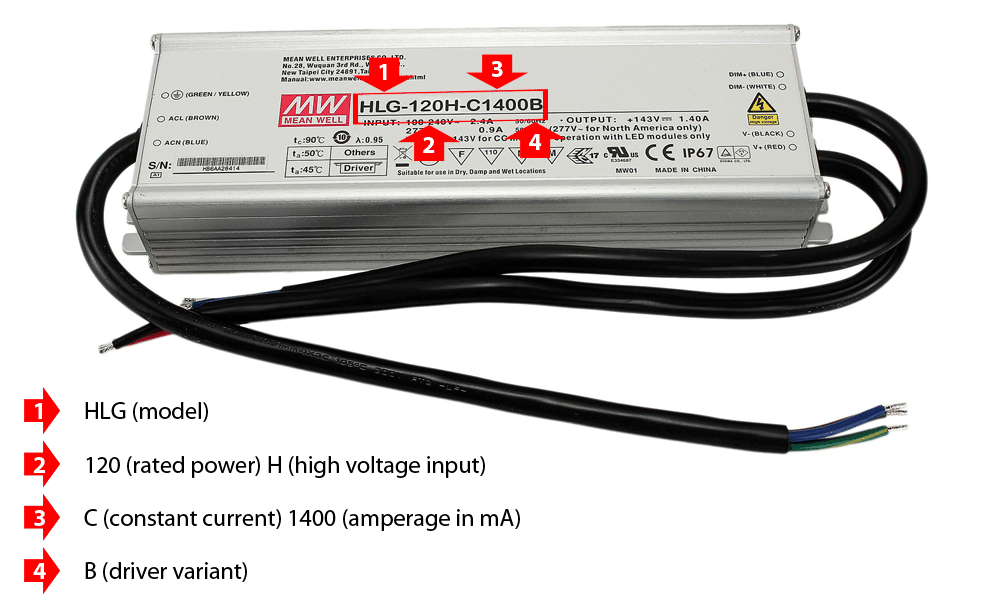
Under number 1 you'll find the name of the model. Next to HLG drivers we also offer ELG and LPC models. Under number 2 you'll find information on rated power given in Watt (120). The "H" stands for high voltage input. Number 3 highlights a "C" and refers to constant current, the "1400" specifies the amperage in mA. Number 4 finally specifies the driver variant. We have two of those variants in stock. Variant A supports an internal dimmer. Using a small potentiometer the dimmer can be adjusted between 50-100%. Variant B supports a 3in1 dimmer-port. You can connect an external 100kOhm potentiometer, an external 1-10V dimmer or an 10V PWM signal.
In theory a CXB3590 will take up to 130 watts if you provide enough cooling. In practice, however, is much more efficient not to max out the chip's capacity. So how does it work with wattage per chip?
The CREE CXB3590's electrical power is dependent on the strength of the current with wich it is powered. Here is an example:
2100mA = ~75W per CXB3590 Chip 36V
1400mA = ~50W per CXB3590 Chip 36V
1050mA = ~38W per CXB3590 Chip 36V
700mA = ~25W per CXB3590 Chip 36V
All drivers offer the option of dimming to at least 50% of the power and so halving the performance per CXB3590. Using the driver from our example we could decide on any value between 1400mA (50W per chip) and 700mA (25W per chip).
This depends on the driver model, which is why there are so many different models. The reasonable thing to do is to max out the driver's capacities because this will maximize its efficiency. Depending on the number of LED-chips, that is to what degree its capacity is maxed out out, its efficiency level will be higher or lower. Have a look at the example to the right. Accordingly the aim of your set up should be to minimize losses through electric parts. In the following table we've listed the drivers suitable for the CREE CXB3590 LED chip we have in stock.
| driver model | voltage range | LED chips | max. wattage | efficiency |
|---|---|---|---|---|
|
|
|
|
|
|
| HLG 60H-36A | 33V-40V | 1x CXB3590 36V | 60Watt | 90% |
|
|
|
|
|
|
| HLG 120H-C1400A/B | 54V-108V | 2x CXB3590 36V | 100Watt | 92,5% |
| HLG 120H-C1400A/B | 54V-108V | 3x CXB3590 36V | 150Watt | 93,5% |
|
|
|
|
|
|
| HLG 185H-C1400A/B | 71V-143V | 2x CXB3590 36V | 100Watt | 93% |
| HLG 185H-C1400A/B | 71V-143V | 3x CXB3590 36V | 150Watt | 93,5% |
| HLG 185H-C1400A/B | 71V-143V | 4x CXB3590 36V | 200Watt | 94% |
|
|
|
|
|
|
| HLG 320H-C1400A/B | 114V-229V | 4x CXB3590 36V | 200Watt | 94% |
| HLG 320H-C1400A/B | 114V-229V | 5x CXB3590 36V | 250Watt | 94% |
| HLG 320H-C1400A/B | 114V-229V | 6x CXB3590 36V | 300Watt | 94% |
|
|
|
|
|
|
| ELG 150-C2100A/B | 36V-72V | 1x CXB3590 36V | 75Watt | 89% |
| ELG 150-C2100A/B | 36V-72V | 2x CXB3590 36V | 150Watt | 91% |
To calculate the number of chips per driver, start with the output voltage. If we stick with our example from above, the driver delivers an output voltage of 54V-108V. Since the chips we want to use need 36V we can divide the driver's output voltage by 36V. As the example driver provides a minimum of 54V, we can't connect a single CREE CXB3590 because the driver provides too much power for one chip. If we connect two LED chips, however, we need 72V which is well within the scope provided by the driver. Finally, to max out the driver's capacities we will have to connect three Cree chips adding up to 108V.
These are the most important things to know about the Mean Well drivers you can find in our shop. If you have any questions just write them in the comments or contact our support via mail.
If you want to read more articles like this please share or leave a like!
After our blog post about the initiation of sleep, we now present the appropriate Far Red DIY-M-Kits and sets, which work in the range of 720-740nm.
The kit is available as a standalone version and can be combined and used with any lighting. In addition, the Far Red kit can be mounted on the previous DIY-M-KITs.
Here are some examples:
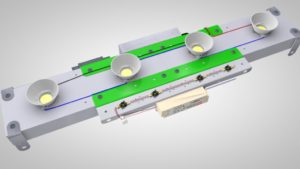
| DIY-M-KIT FarRed Standalone | DIY-M-KIT FarRed extension | FarRed-Addon with driver | FarRed Addon extension |
|---|---|---|---|
| 1 driver 1 heat sink 4 Far Red LEDs connection accessories thermal pad | 1 heat sink 4 Far Red LEDs connection accessories thermal padT | 1 driver 4 Far Red LEDs connection accessories thermal adhesive | 4 Far Red LEDs connection accessories thermal adhesive |
| This is the standalone version that comes complete with all the parts needed for operation. | The extension can be operated with the DIY-M-KIT FarRed, as the driver supports up to 21 LEDs. | This kit does not include a separate heat sink. The FarRed LEDs must be glued directly onto the heat sink of a DIY-M-KIT with the thermal adhesive. | The Far Red Add on extension does not include a separate heat sink. The FarRed LEDs must be glued directly onto the heat sink of a DIY-M-KIT with the thermal adhesive. |
The new DIY-M-KIT FarRed kit and the extensions is available!
Far Red radiation - or Far Red light - designates the far end of the red light spectrum that is visible on the edge between red and infrared light. Usually referring to a wavelength between 710 and 850nm, Far Red radiation can be perceived by various organisms as dimmed light. Plants make use of an absorbance spectrum and read Far Red light as an indicator for nightfall. This mechanism can be utilized in artificial lighting scenarios.
Plants posses a natural photoreceptor called phytochrome, a protein that perceives Far Red light levels in the plant's surroundings. Phytochrome regulates various aspects of the plant's growth such as germination, flower formation and photoperiodism. Photoperiodism designates the regulation of the plant's day and night cycles. Plants display two essential types or conformations of phytochromes: the pr-type (r=red), which has a maximum absorption level of ca. 660nm and the pfr-type (fr=far red) with a maximum absorption level of 730nm.
So what is the connection between phytochromes and grow lights?
It's simple: by utilizing the Far Red spectrum we can influence processes like photoperiodism to optimize the plant's regeneration phase during the night and effect better harvests by optimizing its capacity for photosynthesis. This process is as simple as it is efficient: by leaving Far Red light turned on for 10 to 15 minutes after turning off the regular lights in the evening, the Far Red spectrum will act as an initiator for the natural sleep phase of the plant.
As such the natural day/night cycle of the plant is influenced by the Far Red spectrum in artificially speeding up the process of nightfall. Making the plant "think" night was falling very quickly effects the plant to enter its regeneration phase quicker than it would when using a regular light setup. As a result you can either increase the regeneration time available for the plant without extending the night phase or shorten the plant's night phase without diminishing its regenerative effect. This method is beneficial for artificial grow light setups because it allows to switch from the conventional 12h/12h rhythm of the plant's day/night cycle to a more productive 13,5h/10,5h rhythm. As a result the plant gains additional 1,5 hours for photosynthesis.
In September we launched our first LED measuring day in Bovenden (Germany, close to Göttingen). We met with Bloomtech's Thomas to run the first part of our measurement series. We set up a tent to provide a measurement area of 1m2 and tested various LED lights by different manufacturers.
The measuring marathon ended up being a great day of work and fun. Thomas provided bratwurst and beer (thanks again for that!) and we talked shop about everything LED.
The setup is comparatively simple. We provided 1m2 of measuring space and installed 81 metering points of which we ended up using 25. They are highlighted by the big black dots.
The second tool was a simple rod on which we marked our three measuring heights, making it easy to adjust the lights for our tests.
Finally, the last and most important tool we used was an Apogee Full Spectrum Quantumsensor, a sensor with a spectral range of 389 to 692 nm. To ensure that all lights reached their respective working temperatures before the tests we switched them to full power 15 minutes prior to the actual tests.
The idea behind the tests was to compare the different lights in real life situations and so the heights in which we installed the respective lights was dependent on the specifications of each single light. We used heights of either 30cm, 60cm or 90cm. The goal was to compare illumination and PPFD data if the lights are used either as you would find them in shops or in use by regular customers. The collected data was transferred to an excel-sheet and is listed below.
LED type
SMD
Operational life span
30 000 hours
Power
100W
EQ. Power
1000W
Color temperature
6000K
Color rendering index CRI
80
Dispersion angle
120 °
Dimming function
No
Warranty
5 Years
LED type
Osram & Cree
Operational life span
50 000 hours
Power
416W
EQ. Power
600W
Color temperature
LED Ratio 660nm/630nm/450nm/460nm/3.5k
Color rendering index CRI
-
Dispersion angle
90 °
Dimming function
No
Warranty
2 Years
LED typ
Osram SSL
Operational life span
100 000 hours
Power
97W
EQ. Power
-
Color temperature
-
Color rendering index CRI
-
Dispersion Angle
-
Dimming function
No
Warranty
5 Years
LED type
-
Operational life span
-
Power
245W
EQ. Power
400W
Color temperature
-
Color rendering index CRI
-
Dispersion angle
-
Dimming function
No
Warranty
-
LED type
-
Operational life span
80 000 hours
Power
30W (per Modul)
EQ. Power
-
Color temperature
-
Color rendering index CRI
-
Dispersion angle
90°
Dimming function
No
Warranty
3 Years
LED type
Cree
Operational life span
50 000 hours
Power
640W
EQ. Power
1000-1200W
Color temperature
-
Color rendering index CRI
-
Disperion angle
90° oder 120°
Dimming function
Yes
Warranty
3 Years
LED type
Cree CXB3590
Operational life span
60 000 hours
Power
150W (per Modul)
EQ. Power
450 W
Color temperature
3500K
Color rendering index CRI
80
Dispersion angle
72°
Dimming function
Yes
Warranty
5 Years
You can (and should) make up your own mind concerning the results and we would love to hear what you think - post your thoughts in our support chat or join one of our live streams on youtube (coming soon). Also, we're currently planning on going live with knowledge transfers. Please get in touch with us if you are interested in that regard!
Of course we're always available for questions and feedback in general - maybe you'll even catch us live in the small window below. We hope we've been able to help you with your decision as to which LED grow light is right for you.
If you like what you see here please consider to subscribe to our Youtube-Channel - more info coming soon!
Plants don't grow faster if you pull on their stems. They will grow faster, however, if you provide light conditions that are geared towards healthy and sustainable growth. The question is which measurement values you should consider when planning your lighting conditions?
Opinions are divided concerning this subject. While LUX and lumen values are still widely used among plant breeders, science is offering more and more arguments against this simplified view of light and its properties in relation to plant growth. New findings imply that the average photosynthetic photon flux density (PPFD value) is of greater importance towards plant growth than LUX and lumen values. To understand why this is the case, we need to cover some of the basics concerning photosynthesis and light measurement values.
For our purposes the term "photosynthesis" designates the process of converting water and carbon-dioxide (CO2) into glucose and oxygen used by plants. The basic requirement for this energy conversion is radiation energy and chlorophyll. While water is being gathered by the roots of the plant, radiation energy is provided by the sun in a natural environment.
While humans need oxygen to breathe and produce carbon-dioxide when breathing out, plants work the other way around in that they need CO2 in order to produce oxygen. For this process to work, however, the plant is not only dependent on CO2 but also on radiation energy, that is, light. This is provided by the sun in the form of photons. As energy carriers photons are of significant importance concerning the growth of plants and need to be available in sufficient quality and quantity according to the needs of the individual type of plant. While nature takes care of this by providing the ideal light spectrum of the sun, managing artificial grow light setups to ensure optimal sustenance for plants is a complex process.
To understand which measurement value is best for evaluating the photosynthetic process we need to cover some more basics.
The lumen value describes the luminous flux based on light intensity and solid angle. In a nutshell the lumen value of a light source tells us at which rate light is produced and made available. It does not, however, offer information on the light intensity that actually reaches a certain area because it is not concerned with the dispersion angle of the light source. Further, the lumen value does not take into account the number of photons hitting the illuminated area. As such while the lumen value is useful when ascertaining a setup for straight forward illumination purposes, it does not convey much useful information when it comes to grow light setups.
The LUX value is derived from the lumen value and designates the light intensity that hits a certain area. Since it is not concerned with the number of photons hitting that area, however, the LUX value - just like the lumen value - really is not ideal when it comes to grow light setups and assessing the quality of light emitted by a source.
A solution to this problem is to introduce the measurement value PPF (photosynthetic photon flux). The PPF value is denoted in μmol/s and measures the number of photons being emitted by a given source. If put in relation to an illuminated area, the average number of photons hitting that area is the basis for calculating the average photosynthetically active photon flux density (PPFD value). As such the PPFD value is highly suited to ascertain the quality of light emitted by a given source. The direct PPF value of a given illuminated point is termed its PAR value. While PAR values yield information on certain points of the illuminated area, they should always be considered in relation to the overall PPFD value.
To assess the effect of a grow light on a plant the photosynthetic photon flux density PPFD is what really matters because unlike LUX or lumen values, the PPFD will yield information on the average number of photons actually reaching the plant. To get optimal results when plant breeding, however, you will also have to take into account the available wavelength spectrum of the emitted light.
We use the term "abiotic environmental factors" to denote factors deriving from the non-living environment that have direct or indirect impact on living organisms like humans, animals and plants. The term is clearly distinguished from "biotic" factors, which denotes impacting factors from the living environment.
Typical examples of abiotic environmental factors are light, water, temperature, oxygen content, air humidity or wind velocity. All these factors impact the world of plants in general and define certain aspects like growth, flower formation or germination of the seeds. To reach a desired result when it comes to growing and/or breeding plants, both the abiotic and biotic factors need to meet certain conditions. The specific requirements depend on the type of plant. While shadeloving plants are dependent on high levels of air humidity, light plants usually prefer dry air.
The abiotic factor of light is not only important for plant growth but indispensable for flowering and germination. Plants use light as an energy source to convert inorganic substances like CO2 and water into organic material like glucose, amino acids and lipids. Light has a unique spectral composition. It is indispensable for photosynthesis and provides the basis for plant life. Of course it applies as well that each type of plant has individual needs concerning the intensity of light. While shade-loving plants reach their maximum photosynthetic capacity with low light intensity, light plants are dependent on high light intensity.
To understand the needs of plants when it comes to light a basic understanding of the sun's radiation spectrum is necessary.
Natural sunlight is essentially electromagnetic radiation which is emitted with a certain intensity and wavelength. The electromagnetic spectrum of light covers more than the visible spectrum and exhibits its peak of intensity at about 500 nm. The shorter the wavelength, the higher the energy level of the lightwaves. Concerning plant growth and flowering it is important to understand that plants need the whole spectrum of natural light for optimal growth.
With synthetic lighting setups it is a common practice to focus on the wavelengths around 660 nm and 450 nm. This wavelength range is generally understood to deliver the energy needed by plants for growth, flowering and photosynthesis in general.
However, in his scientifically approved study from 1972 Dr. McCree discovered that the energy levels provided by the red and blue wavelengths alone are not sufficient for maximum physiological development of plants. Examining 22 different types of plants Dr. McCree showed that carbon-fixation, a crucial element of photosynthesis, is taking place using almost the whole range of the visible light spectrum.
As a result it is essential to provide a light spectrum which is as authentic as possible to ensure balanced, healthy and sustainable plant growth. While conventional grow lights usually only provide red and blue wavelengths, lighting systems based on the McCree curve cover the yellow and green frequencies as well. These lighting systems manage to closely approximate the wavelength spectrum of the sun and offer lighting conditions that resemble the plant's natural environment.
Next to reproducing the natural light spectrum as close as possible, critical factors for successful artificial lighting include light intensity and periods of exposure to light. Both, light intensity and periods of exposure are dependent on the individual needs of the type of plant you are growing and both factors have major impact on plant growth and flowering. Studies on photoperiodism have shown that short-day plants prefer shorter periods of exposure to light than long-day plants.
Using state of the art semi-conductors, grow lights with LED technology meet the requirements described above exceedingly well. Lights like our Sunflow offer excellent reproduction of the scientifically approved McCree spectrum, highly efficient modes of operation and long durability.
The abiotic factor light is the most important factor when it comes to plant growth. Scientific studies show that successful artificial lighting depends on offering lighting conditions that are as close to natural light as possible.
There are various methods to evaluate light. Some of them focus on the light that can be used by plants and these are the ones we will take a closer look at: "Lumen is for human!" When dealing with light there are two important factors that are often misunderstood, namely light quantity and quality. Below we will cover the two terms and explain what they mean.
Light quantity or the amount of light correlates directly with the production of biomass - the more light, the more biomass (up to a certain point, of course). As photosynthesis is a quantum process, it can be quantized on basis of photons. In the following we will present three ways of measuring light quantity.
- is the measuring unit which references the overall performance of the light spectrum relevant for plant growth. PPF measures how many photons are emitted by a given light source. The data is denoted in μmol/s. PPF is a very important factor because it shows how much output a light source / lamp will produce.
- the "D" stands for density and yields information on how much PPF is hitting an area of 1m². PPFD values are denoted in μmols/m². Studies on various plant types have shown that 700-1000μmols/m² represent an optimum average PPFD for light hungry plants. Without additional help of CO2, values that are higher than1000μmols/m² are not recommended.
- many know PAR meters and the PPFD values measured by these devices. They are highly useful to see how the light spreads over an area and to measure how much light is hitting a certain point. These values, however, say nothing about the overall light output in relation to the whole area. This why PAR meters are used to measure light at several points of the surface area in order to calculate an average PPFD value.
A widely known form of assessing light quality is to measure the spectrum of available light. An analysis of the light spectrum emitted by a source essentially tells you which different wavelengths are available and how the light is distributed among these wavelengths. The different colors of the light spectrum emerge due to the different energy levels of the photons. The more energy a photon has, the more its color tends towards blue. On the other hand, the less energy a photon has, the more it tends towards the reds. Concerning photosynthesis these colors are used to determine the potential effect a given light has on plant growth. This was shown by Dr. McCree in 1972. He examined 22 different types of plants in regard to how their carbon fixation reacted to different wavelengths of light. The results led to what today is known as the McCree Relative Quantum Yield curve or RQE-curve. Up until today this is the only scientifically recognized study on how potent different wavelengths are in relation to plant growth.
It is important to note, however, that the important wavelengths are not restricted to the red and blue spectrum. While the red and blue wavelengths are driving forces when it comes to photosynthesis and the physiological development of plants, they are not the only beneficial or indeed necessary wavelengths to ensure maximum physiological development and high mass yields. The full white spectrum is necessary to maximize photosynthesis and to correctly trigger biological processes.
If we look at the 3500K spectrum of the Sunflow being overlayed with the McCree RQE curve we can observe the following:
The spectrum provided by the LED-chips we use perfectly fits the McCree curve. The LED's white spectrum delivers a deliberate balance of the whole spectrum between 380nm-780nm. The blue wavelengths increase the production of essential oils and terpenes. In addition to that the Sunflow's light spectrum effects shorter distances between the nodes (nodes = junction points between leaves and branches). The often misunderstood region between green and yellow wavelengths is responsible for balanced and healthy plant growth. The orange to red wavelengths are the driving force behind the plant's fruiting phase and an important factor when it comes to flowering and crop growth.
[vc_row][vc_column][vc_column_text letter_spacing=""]As of now we're packing more MeanWell power and offer new stainless steel brackets for your LED! We've once again extended our product list and we'd like to show you the new products that made it into our shop. But wait, there's more - if you're missing something you think would complement our product range please let us know! If it fits our general product range we're happy to have you participate in creating an even better selection of available products.
To the new products!
Now we're back with new and improved brackets made from stainless steel! Also, to improve on setting up our kits in general we've enlarged the bracket's eyelets so that it's easier to mount the Prohanger units. As of now all our DIY-M-KITs are being shipped with the new brackets![/vc_column_text][vc_column_text letter_spacing=""]
In response to getting more and more requests for bigger drivers that can handle larger numbers of COBs we've updated our product range and are now offering them in our shop![/vc_column_text][vc_row_inner][vc_column_inner width="1/3"][vc_column_text letter_spacing=""]MeanWell HLG 60H 36A[/vc_column_text][vc_single_image image="6139" img_size="medium" onclick="link_image"][/vc_column_inner][vc_column_inner width="1/3"][vc_column_text letter_spacing=""]MeanWell HLG 320H C1400A[/vc_column_text][vc_single_image image="3848" img_size="medium" onclick="link_image"][/vc_column_inner][vc_column_inner width="1/3"][vc_column_text letter_spacing=""]MeanWell HLG 185H C1400B[/vc_column_text][vc_single_image image="3850" img_size="medium" onclick="link_image"][/vc_column_inner][/vc_row_inner][vc_column_text letter_spacing=""]A little tip on how to distinguish the dimmable editions:
The last letter indicates the dimmable editions.
MeanWell HLG 185H C1400 (A) – dimmable with Phillips head, locate the driver und the black rubber hood (stop left 50% - stop right 100%)
MeanWell HLG 185H C1400 (B) – dimmable with external potentiometer (connect to driver using dimm+ & dimm-)[/vc_column_text][vc_column_text letter_spacing=""]
Last but not least a small update on the Ledil Angelina Reflector units - perfect fit for our COB CXB3590 by Cree:
Ledil RZ Defuser Linse - improved protection against dirt and dust for you LED chips![/vc_column_text][vc_row_inner][vc_column_inner width="1/2"][vc_single_image image="3853" alignment="center" onclick="link_image"][/vc_column_inner][vc_column_inner width="1/2"][vc_single_image image="3854" alignment="center" onclick="link_image"][/vc_column_inner][/vc_row_inner][/vc_column][/vc_row]
We'd like to focus on the topic of „High Performance Group – CXB3590 Bin“. As many of you have noticed, every chip has different bins. As you can see in the picture below, the CXB3590 has more than 8 different bins according to which all COBs are sorted independently of their spectrum. The deciding factor in that regard is solely the „Minimum Luminous Flux“.
Even within one and the same production batch the quality levels of the produced LED chips are not uniform.
Example
If we look at a production batch of 100.000 CXB 3590, color spectrum 3500k, we can observe the following distribution of quality levels:
|
AD |
BB | BD | CB | CD | DB | DD | EB |
| 5.000 | 20.000 | 40.000 | 30.000 | 5.000 |
This results in every production batch containing better and worse binnings by default. Because High Performance Group BINS can't be deliberately produced, CREE has not included them in their standard product catalogue. You can find the performance groups in the data sheet on page 14, lower section.
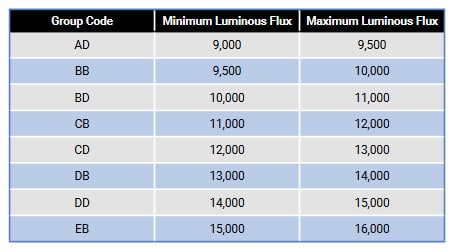
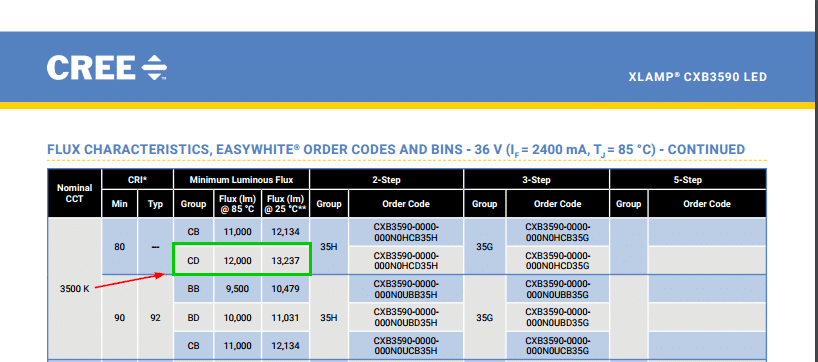
The regular CXB3590 series is grouped according to different quality levels. As you can see in the chart, the top-bin is the CD version. However, occasionally an exceptionally good batch will be produced and in that case a DB version's output can beat the regular series' top-bin by 1000 lumen (10%).
From time to time we can offer a limited supply of High Performance Group chips. We have, in fact, some in store right now. In case you're interested in getting your hands on these rare bins check out our online shop, category LED-CHIPS. If we have them in stock they will be labelled with "TIPP".
Here is a link to the CREE CXB 3590 3500k DB BIN.
Please understand that we can not order these bins on demand and that we can only offer what we have in stock. For logistic reasons they are available only as individual sales.
After comparing set ups and technical performance values of high pressure sodium lights and Cree LEDs we will now cover some essentials and then show the results of our comprehensive tests.
The key to evaluating the performance of a plant light is measuring its PPFD-value (Photosynthetically Active Photon Flux Density). Photosynthetically active radiation denotes the spectrum of sunlight which is used by photosynthetically active lifeforms for growth and flower formation. This spectrum encompasses wavelengths from about 400nm (high-energy blue light) to 700nm (lowenergy red light).
PPFD-values are specified in micromole per square meter and second. The PPFD-value states how many photosynthetically active photons hit an area of 1 square meter over the course of 1 second. When evaluating a plant light it is important to measure its PPFD-value on several different spots to determine a sound average. This average PPFD-value can be used to determine how effectively a plant light will stimulate plant growth.
For our tests we pitted a classic 400 watt high pressure sodium light against a bundle of two 200 watt DIY-M-KITs. Both DIY-M-KITs run four high-performance Cree CXB 3590 Chips each. They were connected by 640mm angles to ensure optimal illumination. During the test all lights were installed 45cm above the measuring surface. Both set ups, the LED chips and the high pressure sodium light, illuminated an area of exactly one square meter.
Visualizing the measured data clearly shows that the COB-LEDs reach significantly higher PPFD values than the high pressure sodium light. While the sodium light reached an average of 618 μmol/m²s, the LED plant lights surpassed this value with 811μmol/m²s under the same conditions.
While both light set ups operate on the same nominal power, the higher effectiveness of the Cree CBX LED chips leads to an overall significantly higher efficiency factor. As a result the LEDs can be dimmed to achieve the same output while using less energy than the high pressure sodium lights. Wether you need lights for plant propagation, overwintering, growing or flower phases - thanks to its high PPFD-value, LED technology is ideal for all aspects of plant lighting.
Missed part 1? No problem, here you go!
In this section we will show you the differences between a High Pressure Sodium light and COB-LEDs and highlight why the LED system represents a big step forward in the field of plant lights. We will begin with a look at the basic equipment. Since we want to compare the efficiency of both systems, we’ll put together two 400 watt setups.
Die 400w High Pressure Sodium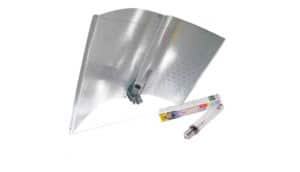 | 8x Cree LEDs each 50w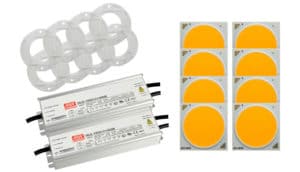 |
| Components - 400w HPS bulb (i.e. Sunmaster) - 400w light ballast (EVG) - reflector(Adjust-A-Wing) - socket cable | Components - 8x Cree LEDs (CXB 3590) each 50w - drivers - cooling element - cables, angle brackets, mounts |
| HPS data - lumen: ca 55.000lm - luminance efficacy: up to 130lm/w - thermal loss: at least 60% - efficiency: 25%-40% | 8x LED chips data - Lumen: ca 72.000lm (at 8x50w) - luminance efficacy: up to 182lm/w - thermal loss: at least 35% - efficiency: 45%-65% |
Gas-discharge lamps like high pressure sodium lights spread their light in all directions. As a result 50% of the light needs to be reflected which in turn leads to a considerable loss of light. Our LED plant lights equipped with Cree LED-chips have a dispersion angle of 115°. Combined with the right set of reflector and holder nearly all of the light can be directed at the plants at a dispersion angle of 90°.
After comparing set ups and technical performance values of high pressure sodium lights and Cree LEDs we will now cover some essentials and then show the results of our comprehensive tests in our second part of our comparison
Hello and welcome to the start of the project LED Grow Light! Here you can now read about our first milestones for the development of an LED Grow Light. Have lots of fun with it!
For us it is finally happening, building a web presence, trade fair visits, development of the first prototype, shop preparation, social media development and expansion, cost accounting, bookkeeping, production, certifications ... as you can see, we have many things to do!
We have a lot of ideas, a good reason for our project and a lot of energy to tackle our LED Grow Light project. Who we are and why we do that, you can find out here on our blog. We will try to take you through all the important steps on the way to our LED Grow Light. So that you are finally able to build your own LED Grow Light. Be curious what else is coming!
Follow our progress until then and be there when we take essential steps, fail, record success and share it with you.
Let's change the use of light together and get more out of Grow Light than previously possible!